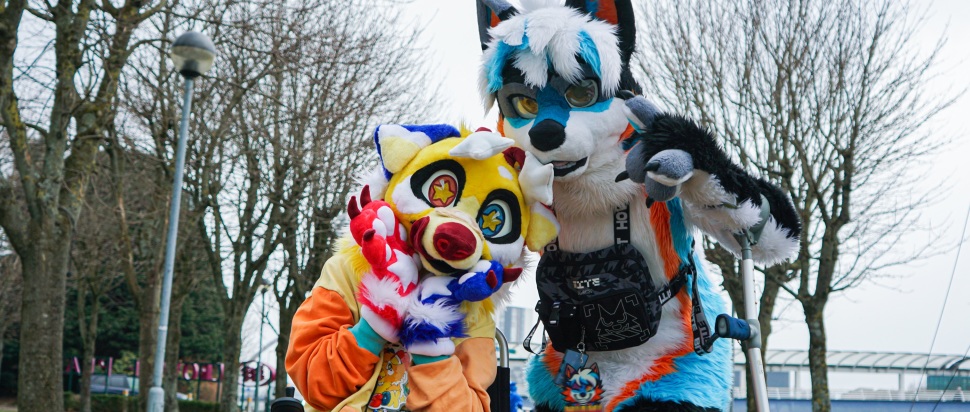Expression by Fur: A ScotiaCon weekend with the furry community
Hot on the hairy heels of ScotiaCon 2025, we chat to members of the furry community about harmful media misrepresentation, the joy of connecting IRL and finding freedom in fur
As breakfast turned to brunch, with knife and fork in hand, thousands of foxes, cats, and dogs began to chow down at Glasgow’s Crowne Plaza Hotel. Skittish neuro-funk flowed from the foyer to the banks of the River Clyde, carried by a brisk breeze. The winter-battered trees swayed, whilst runners, walkers, and their pets alike stood still, rooted in awe, amidst a seemingly infinite sea of colourful characters descending on Scotland’s only furry convention – ScotiaCon.
The furry fandom encompasses a diverse community of artists, gamers, and role players, some of whom create anthropomorphised animal characters they can identify with – also known as a fursona. It’s nothing new: from Dr Seuss to George Orwell, attributing human emotions and behavioural features to animals has long helped foster human connection and understanding in a fun and fresh context.
Existing primarily online, furry alter egos often interact in avatar form through simulated virtual reality experiences. It’s at meet-ups and conventions, such as ScotiaCon, where internet extroverts can connect face-to-face in a safe space, while fashioning their fabric tails, ears, and elaborate head-to-toe costumes, known as fursuits.
“Wearing the suit is a massive confidence booster to be the more outgoing version of myself and have people see me the way I see myself... it’s also super fun,” smiles Jynx, 22, a self-proclaimed indecisive wolf, fox, and snow leopard amalgamation from Ireland.
“Especially as someone who is gay, it’s nice to be in a non-judgemental space surrounded by supportive and like-minded people,” they say. Alongside their involvement in the furry community, Jynx works as a lighting technician and is a hobbyist horse rider. “The community is so diverse in talents and personalities, but with one common interest to bring everyone together.”
Spawning out of America’s 1970s sci-fi scene, alongside Trekkies and a growing interest in cosplay, the furry subculture soon amassed millions of members worldwide. Spreading to Scotland in 2011, ScotiaCon – one of the UK's three annual furry conventions – started as a small hangout in the Highlands, before relocating to the Central Belt. Attendance then increased more than tenfold.
But when growth means selling out 1,300 capacity rooms at a renowned business hotel faster than you can explain the concept of a Sharkwolf, it’s hard to stay unnoticed by the media, and – in the case of furs – even harder to not be damagingly misinterpreted.
“Unfortunately our community is one that does attract a share of negative attention which is unwarranted,” says an organiser. This year, their time at ScotiaCon was spent safeguarding participants from a swathe of photojournalists shooting large lens cameras akimbo style as if on safari. “We are subject to a lot of reporting that accuses us of abhorrent things,” they say, inferring a hyper-fixation on the peccadillo of a few by which tabloids paint the rest to haul ragebait clicks en masse.
“They call us the wee sex-pests," jokes Bandit, 25, a blue 6'2" one-legged cancer survivor bearing resemblance to a fox. “I think people grossly exaggerate how sexual it is, and it’s quite difficult to have to answer to that sort of thing when you’re a strictly safe-for-work creator.”
After hitting it off with his girlfriend over the internet, the viral content creator from Edinburgh flew to Wisconsin, where he quickly became a scene icon and inspiration to pawless pals worldwide after trailblazing the US fur circuit without a prosthetic leg.
“I got diagnosed with osteosarcoma when I was 15 and was in pain 24/7, stuck in either a hospital bed or wheelchair... I wasn’t allowed to have any fun,” he says. “So, when I got my amputation, I wanted to prove your personality doesn’t have to be confined by human constraints – this is the most freedom I’ve ever had.”
Inside the hotel, a panel unpacking the nuances of what it means to be non-human (otherwise described as otherkin) is set to proceed. Across from the artist's alley, a tall yellow bird from Bournemouth flaps his wings, warming up for a dance battle he will later lead. Strutting out the Dealer's Den (the convention’s marketplace) is a small Cumbrian hellhound called Electro, sporting a stylish beanie freshly copped.
Having smashed out an hour of Frenchcore at the Crowne Plaza’s staple feral rave in the early hours of the morning, the young DJ Electro now plays hype man for their friend set to take to the stage after dark for a debut performance. “My first rave was in a volcano at Furality – a virtual reality convention known for its clubs. It’s cool to now be playing real-world parties where I can meet up with friends from the UK, Europe, and America.” Spanning digital and physical realms, art and culture within the furry community is richly diverse.
“We’re a niche community, and an accepting one too, although it’s a shame we aren’t always accepted. ScotiaCon is an event for furries by furries,” Electro says. “Being able to suit up and have fun here has really helped me come out of my shell – I call it expression by fur.”
